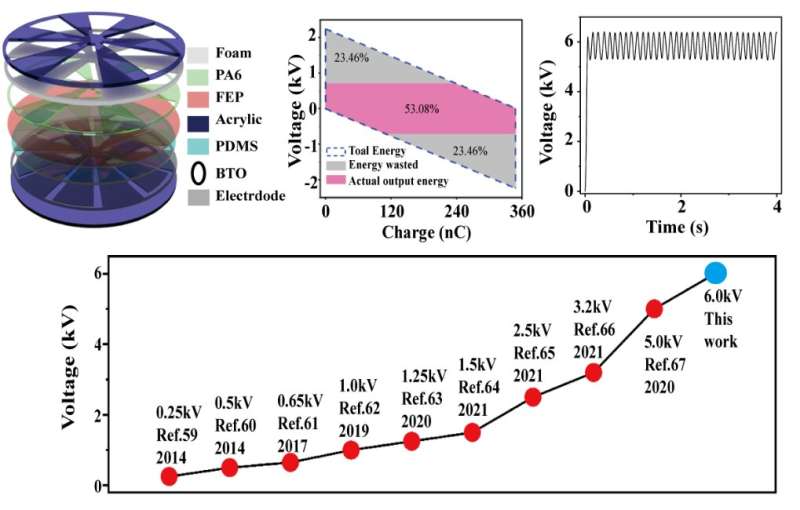This article has been reviewed according to Science X's editorial process and policies. Editors have highlighted the following attributes while ensuring the content's credibility:
fact-checked
trusted source
proofread
Mosquito zappers get a boost from static-electricity harvester redesign

Controlling mosquito populations, especially in isolated or remote areas, is a global public-health priority. In a new study, a team of Chinese researchers advanced this agenda with a more efficient design of safe, self-powered triboelectric nanogenerators (TENGs) to zap mosquitos and mitigate the mosquito-borne diseases.
The study was published in Nano Research Energy on May 23, 2023.
Spreading diseases such as malaria, yellow fever, and the Zika virus, mosquitos kill more people than any other creature in the world, and isolated regions are among the hardest-hit areas. Chemical extermination methods involve toxic materials and pesticides that can pose a threat to human health and the environment. Physical extermination methods use high-voltages to zap the insects, but these approaches can be dangerous and rely on a continuous power supply—which can be hard to come by in more remote areas.
"It is highly urgent to develop a non-toxic, self-powered, and safe high-voltage power source to prevent diseases spread by mosquitoes, especially in isolated islands or remote/poor areas where supplying electricity is difficult," said Xuhua Guo, the first author of this research article from the Ocean University of China.
TENG devices present a promising solution to this problem. TENGs harvest static electricity by converting low-frequency mechanical energy in the environment into electric power. Due to the unique combination of high voltage and low current, TENGs can be designed simply and inexpensively out of a wide selection of fabrication materials, while still being highly efficient with a high-output voltage.
TENGs have already been employed to harvest energy from motion from human bodies, ocean waves, and other low-frequency sources of motion. In order to increase TENG usability and the number of appropriate applications, scientists have been investigating strategies to boost TENG charge density and improve output performance, including ion implantation, triboelectric material modification, structural design and charge chump. However, simply enhancing the charge density will often lead to air breakdown, a phenomenon that decreases TENG output performance and limits the maximum effective power output.
"Air breakdown effect causes the charges generated at the surface of TENG to diffuse into the atmosphere, resulting in charge loss and a decrease in surface charge density," said Guo, who is also an exchange student of the Beijing Institute of Nanoenergy and Nanosystems. "The output performance of TENG has not yet reached the highest theoretical level, so avoiding air breakdown becomes the key to improving the performance of TENG."
Xiaoyi Li's research team proposed a new TENG fabrication design—high-performance rotary triboelectric nanogenerator (R-TENG)—using a customized air-breakdown theoretical model and a ferroelectric nanocomposite interlayer to prevent air breakdown and reduce wasted energy.
In the simplest design of TENG, electric charges are separated on the contact surfaces, and an electrical potential is generated between the surfaces. When the films are separated during motion, an alternating potential difference is formed between the two electrodes, which causes the current to flow. To level up performance, the team's R-TENG design included an intermediate layer with highly oriented barium titanate nanoparticles to increase the surface charge density and the retention ability of the triboelectric charges.
"We also established customized theoretical simulations based on gradient electrode gaps to optimize gap angles and segment numbers of the electrodes, which could prevent air breakdown and enhance the R-TENG output energy by at least 1.5 times," Guo said.
Results of the study demonstrated that, with the help of management circuits, the output voltage can reach 6 kV—among the best-performing triboelectric generators—with the ability to continuously light more than 3,420 LEDs.
"We fabricated a self-powered high-voltage disease prevention system based on the high-performance R-TENG, which not only can effectively kill mosquitoes but also has the power to destroy bacteria in the environment," Guo said.
Next, the research team will focus on improving the performance of TENG and promoting its commercial applications.
More information: Xuhua Guo et al, High-performance triboelectric nanogenerator based on theoretical analysis and ferroelectric nanocomposites and its high-voltage applications, Nano Research Energy (2023). DOI: 10.26599/NRE.2023.9120074
Provided by Tsinghua University





















